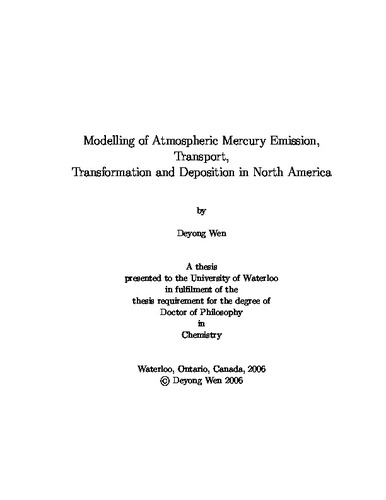| dc.description.abstract | <html> <head> <meta http-equiv="Content-Type" content="text/html;charset=iso-8859-1"> </head>
<body> A modelling study was conducted to explore the emission, transport, transformation and deposition behaviour of atmospheric Hg. A detailed natural Hg emission model was developed to estimate the natural Hg emissions from soil, water and vegetation. U. S. Environmental Protection Agency (EPA) Community Multiscale Air Quality (CMAQ) Hg model system was improved by incorporating the detailed treatment of natural Hg emissions, adopting boundary conditions from a global Hg model (Seigneur et al. , 2004) and including the calculation of the dry deposition velocity of elemental Hg. The natural Hg emission model and the improved CMAQ-Hg model were validated with some measurements and then applied to North America for a whole year (2002).
A detailed natural Hg emission model was developed in this study. This model made use of detailed soil Hg concentration measurements, meteorological data and soil conditions to estimate Hg emissions from soil, water and vegetation. The influence of snow cover and low temperature was also considered in the model. This model was then applied to simulate one-year natural Hg emissions in North America in 2002. The modelled results, compared to some reported natural Hg emission measurements, demonstrated a strong simulation ability. The spatial and temporal variations of emission fluxes were examined through numerical simulations. A pronounced diurnal cycle and a seasonal cycle were found in the emissions from most land uses. Compared with summer, natural Hg emission was significantly limited in winter. Simulation results showed that about 229 metric tons of total natural Hg emission, 1. 8 times anthropogenic Hg emission, was emitted from the simulation domain in 2002.
U. S. EPA CMAQ Hg model system was improved and then applied to simulate the emission, transport, transformation and deposition of atmospheric Hg in North America for the year 2002. The simulated results were compared with measured hourly Total Gaseous Hg (TGM) for 3 sites. The good agreement between them demonstrated the good performance of this improved model in modelling the behaviour of emission, transport, transformation and deposition of atmospheric Hg. Hg budget and net evasion of Hg in North America were also investigated.
A sensitivity analysis was conducted to assess the effects of emissions, including Hg and non-Hg emissions, on the air concentration and deposition of atmospheric Hg. The results indicated that ambient concentration of TGM was much more sensitive to Hg emissions than non-Hg emissions. Natural Hg emission was more significant than anthropogenic emission to affect ambient concentration of TGM, illustrating natural Hg emission is a key factor influencing TGM ambient concentration. Unlike TGM concentration, Hg dry deposition was not only sensitive to Hg emissions but also to non-Hg emissions such as VOCs and NO<sub>x</sub>. Anthropogenic Hg emission, natural Hg emission and NO<sub>x</sub> emission had almost the same effect on total dry deposition of Hg. The results also illustrated that Hg wet deposition was only sensitive to non-Hg emissions such as NO<sub>x</sub> and VOCs, especially of VOCs emission. Because of the inverse effect of VOCs on Hg wet deposition, reducing NO<sub>x</sub> emission should be an ideal solution to mitigate Hg wet deposition. A possible pathway through which atmospheric Hg was greatly affected by emissions changes was identified: emissions of pollutants, especially VOCs and NO<sub>x</sub>, greatly affect the level of OH in the atmosphere; OH influences the concentration and deposition of Hg by significantly affecting the gas phase reaction between Hg(0) and OH. </body> </html> | en |

